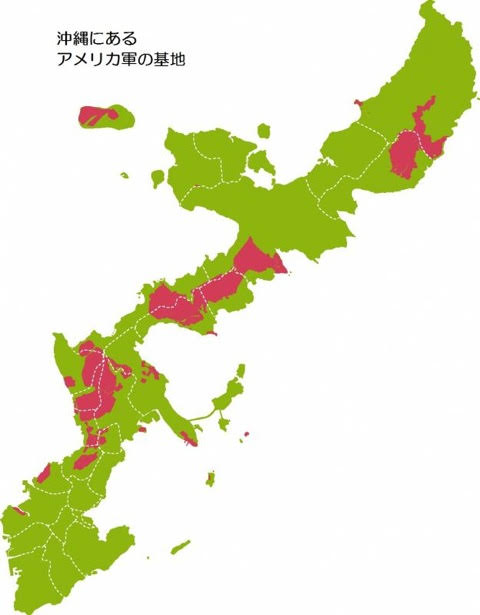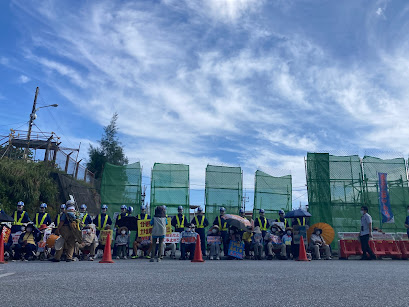Environment and U.S. Bases
Consisting of 160 islands, including 47 inhabited ones, Okinawa, the southernmost prefecture of Japan, is a contentious place. While Okinawa is blessed with the wonders of the island ecosystem, which has nurtured Okinawa's unique culture and lifestyle, it also bears the overwhelming presence of U.S. military bases and training areas.
Environment with Rich-Biodiversity
The most salient characteristic of Okinawa's environment is its biodiversity. For example, the Yambaru Forest in the northern part of Okinawa Island is home to over 1,000 vascular plant species and 190 bird species. A large part of the forest has been nominated for UNESCO World Natural Heritage for its rich biodiversity.
Henoko-Oura Bay, also on the east coast of northern Okinawa Island, provides habitat for 5,300 marine species, including 263 endangered species. Mission Blue, an internationally respected NGO, has recently designated the Henoko-Oura Bay Coastal Waters as a Hope Spot for its biodiversity and people's efforts to
protect it.
U.S. Bases
Meanwhile, Okinawa bears the overwhelming presence of U.S. military bases and training areas. While Okinawa consists of 0.6% of the entire landmass of Japan, 70% of the U.S. military facilities in Japan are concentrated in Okinawa. On Okinawa Island, the U.S. military bases and training areas occupy 15% of the island. Their concentration has been taking its toll on the environment and communities of Okinawa.
In the central part of Okinawa Island, the U.S. Air Force's Kadena Air Base and the U.S. Marine Corps' Futenma Air Station are located in the middle of Kadena Town and Ginowan City, respectively. The communities suffer from aircraft noise day and night; they live in fear of falling objects from aircraft and, worse, of aircraft crashes. Rivers, land, and even drinking waters are found to be contaminated with PFOS and PFAS associated with the bases.
In the northern part of Okinawa Island, the rich environments mentioned above are in danger. In the Yambarou forest, the presence of the U.S. military's Northern Training Area (NTA) within the forest and training conducted in the NTA, including low altitude aircraft flight exercises, affects the fragile forest ecosystem while possibly hindering the forest's bid for UNESCO World Heritage status. At Henoko-Oura Bay, the construction of a U.S. military airbase via land reclamation is now underway to replace the Futenma Air Station (very ironic). Destruction of the marine environment has become painfully evident.
Environmental Justice
Both the Japanese and U.S. governments regard the presence of the U.S. military in Okinawa as an instrument to keep peace, prosperity, and freedom in the Indo-Pacific region. The immense concentration of U.S. military bases in Okinawa is, however, nothing but injustice. And this injustice continues through the governments' manipulation of environmental studies and legal systems as well as their utter indifference to the plight of the environment and communities in Okinawa. Now more than ever, we need to demand environmental justice for Okinawa.
The most salient characteristic of Okinawa's environment is its biodiversity. For example, the Yambaru Forest in the northern part of Okinawa Island is home to over 1,000 vascular plant species and 190 bird species. A large part of the forest has been nominated for UNESCO World Natural Heritage for its rich biodiversity.
 |
| Yambaru Forest Source: Japanese Ministry of the Environment |
Henoko-Oura Bay, also on the east coast of northern Okinawa Island, provides habitat for 5,300 marine species, including 263 endangered species. Mission Blue, an internationally respected NGO, has recently designated the Henoko-Oura Bay Coastal Waters as a Hope Spot for its biodiversity and people's efforts to
protect it.
 |
| Blue Coral in Oura Bay Source: Dugongnosato |
U.S. Bases
Meanwhile, Okinawa bears the overwhelming presence of U.S. military bases and training areas. While Okinawa consists of 0.6% of the entire landmass of Japan, 70% of the U.S. military facilities in Japan are concentrated in Okinawa. On Okinawa Island, the U.S. military bases and training areas occupy 15% of the island. Their concentration has been taking its toll on the environment and communities of Okinawa.
 |
Red indicates US military bases/training areas Sources: Okinawa Prefectural Government |
In the central part of Okinawa Island, the U.S. Air Force's Kadena Air Base and the U.S. Marine Corps' Futenma Air Station are located in the middle of Kadena Town and Ginowan City, respectively. The communities suffer from aircraft noise day and night; they live in fear of falling objects from aircraft and, worse, of aircraft crashes. Rivers, land, and even drinking waters are found to be contaminated with PFOS and PFAS associated with the bases.
 |
| Futenma Air Station in the middle of Ginowan City Source: Gendai Business |
In the northern part of Okinawa Island, the rich environments mentioned above are in danger. In the Yambarou forest, the presence of the U.S. military's Northern Training Area (NTA) within the forest and training conducted in the NTA, including low altitude aircraft flight exercises, affects the fragile forest ecosystem while possibly hindering the forest's bid for UNESCO World Heritage status. At Henoko-Oura Bay, the construction of a U.S. military airbase via land reclamation is now underway to replace the Futenma Air Station (very ironic). Destruction of the marine environment has become painfully evident.
 |
| Land reclamation at Henoko-Oura Bay Source: Ryukyu Shimpo |
Environmental Justice
Both the Japanese and U.S. governments regard the presence of the U.S. military in Okinawa as an instrument to keep peace, prosperity, and freedom in the Indo-Pacific region. The immense concentration of U.S. military bases in Okinawa is, however, nothing but injustice. And this injustice continues through the governments' manipulation of environmental studies and legal systems as well as their utter indifference to the plight of the environment and communities in Okinawa. Now more than ever, we need to demand environmental justice for Okinawa.


